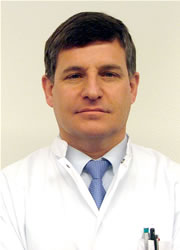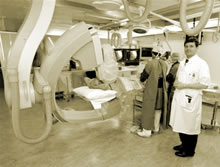|
Q: What is the take away message from the FAME study for interventional
cardiologists? What kinds of patients? I believe that patients who are being treated medically, but still have ischemia, can be helped because it will be possible to discriminate which particular lesions are responsible for their complaints. On the other hand, if patients have multiple abnormalities, let's say four or so, and they need to be helped by bypass surgery, but let's say out of the four lesions, only two are responsible for the ischemia, then you could selectively stent them instead. Bottom line is that by using this methodology routinely, that it's possible to refine PCI, to make it to a safer procedure for more patients. Q: You've previously stated that you think FFR should be an integral
part of every interventional procedure. Do you use FFR on every
case and are there cases where you don't really need FFR? Q: Can’t this information be
achieved non-invasively with nuclear stress testing, like SPECT?
Is FFR
more accurate? Q: Currently FFR certainly is not used routinely. What factors
do you think will drive increased use of FFR? If you are using FFR, you have more sophisticated decision-making. You are measuring something and you have to trust what you are measuring. Of course, this is a big step. If people look at an angiogram and they see a stenosis, their first intuitive reflex is, "Well, we have to put a stent there". And they do not realize that there can be many reasons why that is not as mandatory as it seems to be. If you randomly took 100 healthy people, 60 years old, from the street, and you made an angiogram in all of them, you would find that in 25 or 30 of them, there would be at least one significant stenosis by angiography. But the majority of these lesions are harmless for the people walking around with them. And that is, of course, the job of PCI: to select those lesions which are dangerous for the patient -- and by stenting these to be of benefit. Q: Can you explain how a lesion that looks significant on standard angiography really isn't. What are the tricks that angiography plays on our eyes?
A third point is that, if you have a very smooth stenosis, which is the same severity as an irregular stenosis, with an irregular surface, then the obstruction to blood flow by turbulence can be quite different. So these are a number of angiographic technical shortcomings. There are many other reasons. If you have a particular stenosis and in an artery that is providing blood flow to a small area of the heart, of course, then it's less significant than in an artery that provides a large area. There is a kind a relation between a coronary artery and the myocardial territory to be supplied. And this information, this coupling, I would say, is not given by the angiogram, but it is given by the blood flow and by the pressure gradient. Another example is that if you have an artery that is supplying the part of the myocardium which has a previous infarction and which in part has become fibrotic, the same stenosis which could be significant in one case is not significant anymore in the other case. And there can be collaterals supplying the myocardium, and they also make the particular stenosis less significant. So there are many technical and physiological reasons which make the relationship between anatomy and physiology not one-to-one. Q: I have a question about patients
who will be reading this. News reporters will be reporting
on the
FAME trial and I bet there
will be headlines, for example, that proclaim, "Stents Don’t
Work", or "Too Many Angioplasties are Being Done". Patients should not be disquieted or scared and they should not lose their trust in interventional cardiology. But they should be aware that intervention can be made safer and more to the point by using FFR. Instead of getting three stents, as was the case in the angio group, two stents can be sufficient, even better, and make the procedure safer and cheaper. So I think that stenting in itself is a very good procedure, but by this new technique, we can very nicely refine it, and best define where we have to place the stent in the best possible way. So it's not a matter of stenting or not stenting. But it is a matter of placing the right stent in the right spot. Q: Why would stenting a lesion that doesn't cause ischemia cause
an increase in MACE? Obviously putting in 1/3 more stents raises
the risk of restenosis and the need for a repeat PCI. But why would
stenting a non-ischemic lesion cause an increase in heart attack
and death? On the other hand, if you have a stenosis that is creating repetitive ischemia, we also know from many studies that these lesions have a much higher risk for death or acute myocardial infarction. So the risk of these lesions causing a heart attack is much higher, and they are causing angina for the patient. So these lesions, which have natural risk of 5 to 10% of creating an infarction or death in the next year, can be reduced to 3%, using a stent. So suppose you have four stenoses. And two of them are ischemic and two are not. And the two ischemic ones have an intrinsic risk of 5% and the other two of 1%, you can stent them all and you wind up with 12% risk (3% x 4 stents). But if you only stent the two ischemic ones, for those two you are reducing the risk without causing an increased risk to the other two (a total risk of 8%). That is the conclusion of the FAME study, which shows that if you have an ischemic lesion, you are reducing the risk by stenting, because the intrinsic risk is higher than the risk of stenting. Whereas, if you have a non-ischemic lesion, the intrinsic risk of such a lesion is lower, so it doesn't really make sense to place a stent over there. Q: There was a recent article in the New York Times stating that
too many stents and too much angioplasty is being done; that cardiologists
are looking at the wrong things because heart attacks and deaths
are NOT caused by blockages but by milder-looking vulnerable plaques
that rupture. But that's not exactly what you're saying. Q: The FAME trial is sort of a sequel to the DEFER trial that
you ran several years ago, and this kind of enhances the message
even more. Do you think that the results of the FAME trial are
going to change the way interventionalists approach their cases? Q: An editorial accompanied publication of the FAME study, written
by Dr. Steve Ellis from the Cleveland Clinic. He thought the study
was important, but he would have liked to know how the decision
to stent in the angio-only cohort was made. He had other questions
as well. Dr. Ellis made a couple of more comments. He mentioned that the rate of peri-procedural myocardial infarction was high, but that was not the case. He said we don’t know the data and he suggested that it would be 7.5%, but it was actually 3.4% in the angio group and 2.4% in the FFR group. So it was not higher than in the other studies. And he mentioned a couple of other studies, like COURAGE and ISAR, but in those studies, patients with acute coronary syndromes were not included, and in ISAR, diabetes type 1 patients were not included, and the average number of lesions in those patients was only 1.3 or something like that. And in the FAME study, we had a lot of severe disease with an average of three vessels which were stenotic. We also had patients with very low ejection fractions, patients with acute coronary syndrome -- that was 30% of the population -- we had patients with previous PCI, so we had a population typical of the every day population we see in the cath lab. During the procedure, we used also used thiopyridines, or Plavix: a loading dose of 600mg was used in all patients and IIb/IIIa inhibitors were used in 31% of the patients, which is also the average. Q: Do you think that if the recommendations of this study were
followed, less stents would be used? Q: FFR is done during a diagnostic angiogram. Is this technique
hard to learn, is the equipment setup more complicated? (The FAME Study was supported by unrestricted
research grants from Radi Medical Systems and Stichting Vrienden
van het Hart Zuidoost
Brabant. Medtronic provided limited financial support to some centers
by tailoring the price of the Endeavor stents to the local reimbursement
system.) This interview was conducted in January 2009 by Burt Cohen of Angioplasty.Org. |




